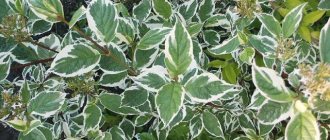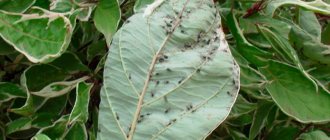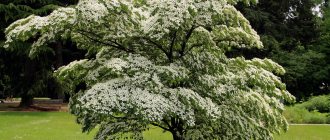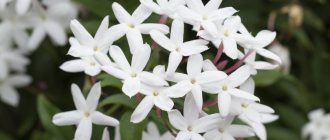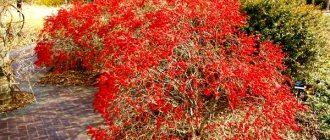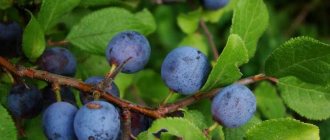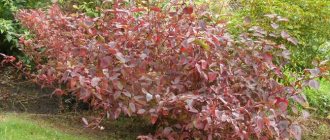Author: Elena N. https://floristics.info/ru/index.php?option=com_contact&view=contact&id=19 Category: Garden plants Published: February 07, 2019Last edits: January 13, 2021
White dogwood (lat. Cornus alba), or white svidina, or white svida, or white telecrania , is a species of the genus Dogwood of the Dogwood family, a close relative of the svidina scion, or silky. The natural range of the plant covers Mongolia, China, Korea, and also extends from the European part of Russia to the Far East and Japan. White turf grows in the undergrowth of swampy dark coniferous forests. The generic name of the plant is translated as “horn”. The white derain shrub, as the most common cultivated species, is widely used in urban landscaping.
Planting and caring for white dogwood
- Flowering: abundant in the first half of summer, repeated in early autumn.
- Planting: in spring before sap flow begins or during leaf fall.
- Watering: seedlings are watered 1-2 times a week, adult plants - 2-3 times a month during dry seasons, spending 1.5-2 buckets of water on each plant.
- Feeding: when growing in fertile soil, you don’t need to feed, but in poor soil in the spring, 100-150 g of complex mineral fertilizer is added to each bush, and in the summer - 5-7 kg of humus.
- Pruning: from the age of three, twice a year: in July and August. Species with brightly colored bark are pruned in early spring once every few years.
- Reproduction: seeds, layering and cuttings.
- Pests: scale insects and aphids.
- Diseases: powdery mildew.
Read more about growing white dogwood below.
Red derain, or blood-red svidina
Another species is red dogwood (Cornus sanguinea). Slightly less common in gardens than white derain. Flexible green shoots acquire a red tint over time. The pointed, ovate leaves are covered with villi. Dark green in summer, they glow in all shades of red in autumn. Thanks to the autumn color of the leaves, the species got its name. Blooms in the seventh year at the end of spring. Small white flowers are collected in inflorescences-corymbs. Sometimes re-blooming occurs. In August, black round inedible fruits ripen.
Red dogwood is also an unpretentious species, quite frost-resistant, but in very severe winters it can freeze a little.
It has decorative forms and varieties:
- Compressa (Cornus sanguinea Compressa) is a very interesting shrub with compressed, rounded leaves. The foliage is dark green in summer, turning red in autumn. The crown is dense, vertical, about 1 m high. The bark on the branches is reddish-brown. Doesn't bloom.
Red Derain "Compress"
- Winter Beauty (Cornus sanguinea Winter Beauty) is the owner of a round, spreading bush (about 2 m). The shoots are orange-yellow. The leaves are oval, pointed upward. Dark green in summer and red in autumn.
Red Derain "Winter Beauty"
- Midwinter Fire (Cornus sanguinea Midwinter Fire) is a spreading shrub up to one and a half meters, the shoots are bright red-orange. The leaves are rich green in summer, changing color from yellow-orange to dark red in autumn.
- Variegata (Cornus sanguinea Variegata) is a variety with variegated leaves, they have yellow-white spots and a border on a green background, then the leaves turn red. Young shoots are green, but gradually acquire a burgundy hue.
Let us also note some more decorative forms:
- Atro-sanguinea - with deep purple branches.
- Viridissima - distinguished by bright green fruits and shoots.
- Mietschii - young twigs and leaves of an unusual light yellow color.
The varieties of blood-red sow we considered, like the white sod, are frost-resistant.
Botanical description
White dogwood is a branched shrub with straight, bare and flexible branches of coral-red, black-red or red-brown color, arching with age. The height of the white tree can reach 3 m. The leaves of the plant are from 2 to 10 cm long and 1 to 7 cm wide, opposite, entire, elliptical, petiolate, pubescent, with three to five obvious arcuate veins. The upper side of the leaves is dark green, the lower side is bluish. Small white flowers with four petals are collected in dense terminal corymbs with a diameter of 3 to 5 cm. Abundant flowering occurs in the first half of summer, and in early autumn the white dogwood blooms again. The fruits of the white tree are berry-shaped drupes, bluish when unripe and bluish-white, flattened when ripe. Both the white turf tree blooms and bears fruit from the age of two to three years.
White dogwood is winter-hardy, heat-resistant, shade-tolerant, and grows well on any soil and in urban conditions. He is as beautiful as he is unpretentious.
Variegated leaves changing color
The wild-growing tree has broadly elliptical leaves (up to 10 cm long) with a sharp tip, dark green, and lighter on the reverse side. In autumn they take on a red-violet hue.
Varietal plants have even more attractive leaves. Depending on the variety, their color can be yellow, reddish, two-colored, spotted, and there are also specimens with a light border.
Planting white dogwood in open ground
When to plant
Planting white dogwood and caring for it do not require any special skills. White dogwood can be planted in early spring, before sap flows, or during leaf fall. For most gardeners, autumn planting is preferable, since with the onset of spring, overwintered seedlings immediately begin to grow. If you decide to plant white turf in the spring, try to preserve as much of the soil in which the seedling grew on its roots in order to protect the root system from stress during transplantation.
- Growing godetia seedlings: sowing and picking
White dogwood grows normally in partial shade and even in the shade, so it is often planted under trees or along blank walls and fences. However, variegated forms require bright lighting, otherwise their foliage loses its original color.
How to plant
The composition of the soil is not of great importance for the plant: white turf can grow on light sandstones, rocky areas, and heavy loams. The only requirement is a neutral level of soil acidity.
The best planting material is seedlings no older than 4 years old: they quickly take root and produce many young shoots after pruning. Before planting, place the root system of the seedlings in water for several hours so that the roots are saturated with moisture and adapt more easily. Seedlings with a closed root system do not need such a procedure.
The size of the planting hole for white deer should be a quarter larger than the volume of the root system of the plant with a ball of earth. In order for white turf to grow and develop normally in swampy soil, it needs to be provided with good drainage: a layer of broken brick or crushed stone mixed with sand, about 15 cm thick, is placed at the bottom of the hole. If the soil in the area is dry and groundwater lies on at great depths, drainage in the planting hole can be omitted at all or just a layer of sand can be used.
Fill the space around the roots with a mixture of soil from the top fertile layer with compost and humus. After planting, the surface is compacted, watered abundantly, and when the water is absorbed, the tree trunk circle of the seedling is mulched with organic material. The root collar should be at surface level.
How to grow a hedge from turf
A turf hedge is an excellent alternative to building a fence. Plants will saturate the area with oxygen. The foliage will not interfere with the air circulation. On a sunny day, the pig will cast a shadow, creating coolness. As it grows, it forms an impenetrable wall for outsiders.
Growing a living fence from turf is not difficult; turf grows quickly. Plants are planted tightly in a row. When planting, you need to take into account varietal characteristics in order to correctly choose the optimal distance between plants.
White dogwood care
Although the white derain bush is unpretentious, it still requires attention. Care of the tree consists of watering, loosening the soil and removing weeds in the tree trunk, fertilizing, pruning and protection from diseases and pests.
- Stevia: cultivation, properties, types and varieties
Young and newly planted plants need watering the most, which need to be watered 1-2 times a week. Mature turf is watered only in severe drought. In the hot season, 2-3 waterings per month are sufficient, using 1.5-2 buckets of water per plant. After moistening, loosen the soil in the tree trunk circle and remove weeds.
Feeding white turf is desirable, but not necessary, especially if it grows in fertile soil. In order for the plant to have a healthy and blooming appearance, you can add 100-150 g of complex mineral fertilizer to each bush in the spring, and 5-7 kg of compost or humus in the summer.
Regular formative pruning of white tree is carried out from the age of three, otherwise the lower part of the bush will soon begin to become bare. In order for the bush to maintain its compact appearance, you need to remove every third or fourth shoot on it, leaving only strong and developed branches on the plant. Hedge bushes are cut for the first time in July, and the second time in August, after the shoots have grown. Tree varieties with brightly colored bark are pruned once every few years in early spring, before buds begin to bloom: the bushes are cut completely at a height of 20 cm from the ground. This pruning stimulates the growth of many young shoots.
As for the formation of a bush, the popular forms in landscape design are column, arc, hemisphere, cube, ball and other shapes. You can form the plant in the form of a standard tree, in one trunk. Or you can maintain the natural shape of the crown, especially since some varieties of white tree look great without formative pruning. Such plants only need annual sanitary cleaning.
Adult white dogwood bushes are rarely affected by infections and pests, but young shrubs can be vulnerable to powdery mildew, scale insects and aphids. As soon as a sloppy whitish coating appears on the leaves of the plant in spring, immediately remove the affected branches and treat the bush with one percent Bordeaux mixture or Fundazol solution. And against aphids and scale insects, you should use a solution of any acaricidal drug, for example, Aktar, Aktellika, Akarina, Bankola or Biotlina.
Possible problems
The shrub has lost its decorative value, which means that errors were made when caring for the plant. When errors are eliminated, the derain will again delight with its beauty.
The bush is untidy, with “bald” or shoots sticking out to the side: the plant needs a haircut.
Leaves are limp, drooping: this usually happens during prolonged drought. Abundant watering will return the plant to a healthy appearance.
Spots and plaque have appeared on the leaves, leaf plates are curling: these are signs of a disease that needs to be identified and measures taken to combat it.
Reproduction
White dogwood is propagated by seed, layering and cuttings. The germination rate of plant seeds is close to 100%. Derain is sown in the fall, immediately after collecting the seeds. You can sow white dogwood in the spring, since its seeds remain viable for up to five years, but during the winter they need to be stratified by keeping them in the refrigerator for at least two months at a temperature of 5 ºC. Sow turf with a density of 5 to 15 seeds per m², sowing depth - 4-5 cm. Seedlings germinate for a very long time, sometimes in the second or third year. And keep in mind that when propagated from seed, you will get a standard-sized white dogwood bush only after 5-8 years.
Varietal plants are best propagated by quick and more productive vegetative methods. How to propagate white dogwood by cuttings? At the beginning of June, cut slightly woody cuttings with 7-9 buds from a strong, healthy bush and plant them in a container with suitable soil. Rooting is best done in a greenhouse. Caring for cuttings involves moistening the soil and fertilizing with organic and mineral fertilizers. By the beginning of autumn you will receive independent seedlings with a well-developed root system.
- How to sow lobelia in snow (and other fine dust seeds)
The easiest way to propagate white dogwood is by rooting cuttings. In the spring, tilt the low-growing flexible shoot of the plant towards the ground and completely immerse it in a pre-dug ditch, leaving only the tip above the surface. Secure the branch in this position and fill the groove with nutrient soil. During the summer, do not forget to water the cuttings and feed them with fertilizers. For the winter, it is better to cover the cuttings with leaves or spruce branches. The seedling can be replanted to a permanent location next spring or autumn.
Derain kouza, or Japanese dogwood
This species, unlike such as white dogwood and blood-red dogwood, is a tall, beautifully flowering shrub, or even a tree, and can reach a height of 9 m. The homeland of cornus kousa is Japan (also found in the wild of China and Korea).
The crown is wide-spreading, old branches descend strictly horizontally and form tiers. The leaves are oval, pointed at the top. The foliage is dark green in summer (with a bluish tint below), and with the onset of autumn their palette diverges from golden yellow to dark crimson. Flowering begins in June. The flower is a simple yellow-green head, collected from small flowers, around which bracts-involucre leaves (bractea) are located. It is the bractae (up to 9 cm) that make the flowers beautiful, as they have an interesting shape and color. At the end of August, the drupes ripen. They are pink in color and slightly round in shape, similar to strawberries (about 2 cm). The fruits are edible.
Decorative varieties:
- Satomi has rose-red bracts;
Derain kouza "Satomi"
- Gold Star is distinguished by a yellow pattern in the middle of the leaf;
Deren kouza "Gold Star"
- Milky Way has high yields and creamy bracts;
Derain kouza “Milky Way”
- Schmetterling is a profusely flowering variety with white bracts.
This species is considered an “aristocrat” and the most beautiful among its fellows. But, unfortunately, it is less resistant to our winters.
Varieties
There are several decorative garden forms and many varieties of white wood. Garden forms include:
- white derain argenteo-marginata is a plant with red bark and green leaves edged with a creamy white rim. In autumn the foliage turns carmine red. The most popular variety of this form is the white derain Elegantissima - a shrub up to 3 m high with spectacular red shoots and a wide, uneven creamy-white border of leaves, on which, in addition to the border, there are cream-colored spots and stripes;
- garden form of Sibirika - low-growing plants with bright red shoots and light green leaves, which turn red-brown in autumn. White derain Sibirika Variegata is popular - a shrub up to 2 m high with a wide creamy border of leaves, as well as spots and streaks of cream color. In autumn, the green part of the leaves turns purple. The variety is similar to Elegantissima, but grows more slowly, making it suitable for small gardens. White Aurea is also in demand among gardeners - a shrub up to 2 m high with pale yellow leaves, reddish shoots, creamy-white flowers and bluish-white fruits;
- garden form of Kern - plants with green leaves with yellow spots;
- white derain Shpeta is a garden form, bred about a century ago and representing plants up to 2 m high with brown-red shoots and a wide, uneven golden-yellow border along the edge of green leaves. In autumn the leaves turn purple;
- white derain Kesselrings are plants with black-red or purple-black shoots.
The following varieties of white dogwood are also in demand in culture:
- Astrosanguinea is a plant with green leaves and crimson shoots, reaching a height of one and a half meters;
- Allemanz Compact is a bush with bright green foliage and red shoots when young;
- Aurea Elegantissima - a bush up to 2 m high with yellow-pinnate leaves;
- Blood Good is a shrub 2-3 m high with red-coral shoots and leaves;
- white derain Gouchaulti (Guhalti, Gusholti) - a plant with blood-red shoots and slightly drooping green leaves with white, pink and red spots;
- Ivory Haylow - a variety with a spherical crown, red shoots and green leaves with a wide white-cream border;
- Sibirika Ruby is a shrub up to 1.5 m high with coral-red shoots, rounded dark green leaves, which turn red-violet in autumn.
Popular types – 4 options
Turf is widely known in Russia and Europe; it is often used by specialists to create hedges in gardens, parks, city squares, on personal plots and on the sides of roads and highways. It is loved not only for its decorativeness, but also for its unpretentiousness to living conditions, as well as a wide selection of varietal varieties used in landscape design. The ranking presents the most popular varieties, their descriptions and distinctive features.
Elegantissima
The representative of white turf is very popular and is found in almost every garden. It has earned particular value thanks to the decorative coloring of its leaves, which makes it attractive even without flowers and berries.
Elegantissima has another rather original name - Argenteomarginata, and is a bush up to three meters high with a lush crown and spreading, intertwining branches. The bark of the shoots is green, and closer to autumn it turns red, old branches turn burgundy. A bluish coating is visible on the surface, in some places it is especially noticeable.
A characteristic feature of the variety is the color of the leaves: gray-green with white edging or strokes, the bottom is gray, the entire surface is slightly corrugated. During the flowering period, the plant is covered with creamy inflorescences, and then forms whitish fruits with a yellow or blue tint, which cannot be eaten. The lifespan of this modest but elegant shrub is 40-50 years. It begins to bloom for the first time in the third year after planting the seedling; this happens twice per season, but repeated flowering does not always occur. It has high frost-resistant qualities.
Sibirika Variegata
Another equally attractive variety of turf is very similar in appearance to the previous variety. But Sibirika, unlike Elegantissima, has a smaller growth (1.5-2 meters) and bright red shoots throughout the entire period. The leaves are light green with cream strokes and edges; the flowers are white with a yellowish tint, collected in corymbs; The red sprouts breaking through the foliage give Variegata special expressiveness.
Flowering begins in May-June and may repeat in September, but this depends on climatic factors. After the buds wither, blue-blue fruits with a clear waxy coating are formed. In the fall, all green foliage turns purple and purplish red.
The variety is used as a garden decoration and hedge; its compact size is appreciated in small gardens. It has drought- and frost-resistant qualities, combines well with spirea, coniferous and deciduous shrubs and trees, and can grow in partial shade and in open meadows.
Read! Gray spirea is a snow-white beautiful shrub.
Aurea
The deciduous shrub easily tolerates Siberian frosts and drought, and in humid and warm climates it is capable of double flowering per season. It grows in sunny areas; in partial shade the characteristic golden color of the leaves does not appear.
The maximum height of the turf does not exceed two meters, and the diameter is 2-2.5 m. The leaves are matte, wide with a yellowish color, the most unusual of all plant varieties. The branches are erect, with a characteristic burgundy hue. The bush tolerates pruning and shaping well.
Shpeta
Another variety of turf has an equally original appearance, and this is Shpeta. A characteristic difference is the color: the yellow-green leaves look impressive when surrounded by various plants. The surface of the foliage is matte, with a lot of wrinkles; The color is green with a rich yellow edging.
Thanks to the increased interest on the part of gardeners, many hybrid specimens are being bred from the variety, the selection of which is carried out in Germany. Shpeta is well adapted to various climate vagaries and is practically not susceptible to diseases and insect attacks, mainly caterpillars and spider mites. Propagated by suckers and cuttings.
All varieties are unpretentious and easy to care for. They are willing to pay for timely watering, pruning and fertilizing with juicy, large leaves, and correct shaping of the bush will allow you to decorate the garden with unusually beautiful and lively decor.
White dogwood in landscape design
Most often, white turf, which is flexible and can easily be pruned, is used to create a hedge. Variegated and beautifully flowering forms of white derena are spectacular both as solo plants and in group compositions. Due to the fact that white derain thrives in waterlogged soil, it is often used to decorate and strengthen the banks of artificial reservoirs, where it gets along well with hostas and other coastal perennials. White turf is also planted in areas with complex multi-level terrain.
How to grow dogwood in the garden - planting and care
Since white derain grows equally well in sunny areas and in the shade, it is often planted under large trees. Bright shoots and leaves of the tree go well with evergreens. The indisputable advantage of white dogwood is that it remains attractive throughout the growing season.
Application in the garden
Derain is a versatile shrub. It can be planted as a single feature, in compositions, in large uniform groups, or in combination with yellow-shooting dogwood species, the glossy dogwood (Cornus sericea). It is great for hedges and looks great in city greenery.
Compactly formed shrubs of low-growing varieties look good both in a small garden and in a large landscape park. The high resistance of turf to low temperatures makes it possible to plant bushes throughout the country. The shrub does not require special protection of shoots from frost.
The shoots of the plant are red, so the bushes are a spectacular winter decoration. This color is preserved only on young, maximum 2-year-old shoots. Therefore, it is recommended to regularly trim old shoots so that the bush is renewed.
White derain is one of the most popular garden shrubs. Almost every part of it is decorative - red shoots, beautiful leaves, flowers and fruits, good crown shape. The shrub is hardy, undemanding - not afraid of severe frosts, withstands drought and urban conditions.
Briefly about the history of appearance
Weigela shrub - an ornamental flowering plant for the garden
The homeland of turf is the northern territories of the globe with a temperate climate. The shrub is especially common in Canada and the northern territories of the United States. Some species grow only in Japan and China. A lot of varieties are found exclusively in Russia.
Derain is in great demand among gardeners
Blooming derain
This species came to us from North America and is a deciduous tree with a spreading crown. Flowering dogwood (Cornus florida) is famous for its abundant flowering, which occurs even before the leaves appear. The flowers are inconspicuous, small, collected in a small head. Their beauty lies in the large bracts, which come in different shades. It is these modified leaves in the spring that turn the flowers into large stars and attract the attention of others.
In the summer, the leaves of this type of tree are simply green, but in the fall, like its fellows, it does not give up its position and colors the foliage in bright yellow, orange and red tones.
This species also has decorative varieties, differing mainly in the color of the bracts.
- Rubra is the most popular of these and the bracts can be colored from light pink to deep red.
Blooming dogwood "Rubra"
- Cherokee Princess - has snow-white bracts.
- Cherokee Chief - captivates with dark pink bractae.
Blooming dogwood "Cherokee Chief"
Although this species can withstand frosts of more than 20 degrees, it is not as winter-hardy as white dogwood and can freeze slightly.
Replanting turf
Replanting turf when it is growing healthy and properly maintained is not necessary and is purely a matter of personal preference and necessity. It is recommended to replant the bush in the spring, before the buds begin to swell. The bush is dug up along with the soil at the roots and transplanted into a hole previously dug for replanting. It is better to add humus or rotted leaves into the hole before planting. After planting, the turf is watered generously with slightly cool rainwater.
Important! The bush is dug out carefully so as not to damage the root system.
NEW OF THE DAY!
Remontant fig Brunswick Remontant fig Brunswick Ficus carica Brunswick
Figs are a deciduous subtropical crop native to Asia Minor. This is the oldest growth, as it was cultivated by people. The ancient Arabians were the first to start growing figs, and then they passed on to the Syrians and Egyptians.
Brunswick is one of the most frost-resistant (termometer) varieties of figs (snowman), appearing in Georgia in 1901. Characterized by self-fertility, repairability, early ripening terms.
The fruits are contorted pear-shaped with a flat top, light green with a purple blush and light pubescence. Vaga ranges from 70 to 200 grams. The fragments of figs are exposed to frost (snowflake) down to -20 degrees, then in Ukraine they grow without protection. In the lower regions, the crop requires protection for the winter: the shoots are pressed down to the ground, tied and mulched or covered with agrofibre.
| (066)050-60-01 | (050)442-07-28 | (096)298-65-79 | (063)619-77-55 | (099)240-49-91 | Wholesale |
Mon-Fri 9:00 – 18:00
–>
Selecting page language
| (066)050-60-01 | |
| (050)442-07-28 | |
| (096)298-65-79 | |
| (099)240-49-91 | Wholesale |
| Russian |
Plants
Sections
Basket
| The cart is empty. |
Reviews
Reklama
White dogwood Aurea Cornus alba Aurea White dogwood Aurea
Planting: In order for White Aurea to grow well, before planting we recommend freeing the soil from weeds, especially perennials, and fertilizing it with nutrients (chernozem or any healthy humified dark meadow/garden soil). It is better to buy seedlings in a plastic container with fertilizers, so the plant is not dug up with inevitable damage to the root system and is guaranteed to take root after planting. Bare-root plants also take root well (when planted in spring or late autumn). White dogwood Aurea gratefully responds to the application of mineral and organic fertilizers. In poor sandy soils (Ukrainian Polesie, including most of the Kyiv region), we recommend adding compost (obtained from garden, garden, and kitchen waste) or old organic humus from composted manure. Organic matter will significantly improve the structure of “light” soils and “launch” the eternal natural engine of soil bacteria. As a result, worms from your neighbors themselves migrate to you and start a chain reaction of a perpetual organic motion machine. Having learned to “maintain” it, we will forget about expensive imported mineral fertilizers forever. The time has come to get rid of the wild lousy habits of destroying (conquering) nature for the benefit of man. It is more expedient to sort waste, as in Europe, taking care of future generations.
Watering: When planting White Aurea Derain (regardless of the weather), water it abundantly at the rate of 3-5 buckets of water for each bush and mulch (humus, straw, grass). Watering must be repeated after 5-7 days - with 2-3 times of watering, the soil capillaries are connected, the planting ball is not separated from the rest of the soil and remains constantly moist.
Pruning: It is advisable to do it in the second year after planting, in the first half of April and early August, removing weak and poorly developed shoots. White dogwood tolerates formative pruning well.
Care: Needs regular watering, removing weeds, loosening the soil.
Diseases and pests: In order to choose the right plant protection product, it is necessary to identify the pest (diagnosis). Untreated plants can be damaged by the hawkmoth caterpillar, anthracnose (leaf spot), powdery mildew and aphids. To protect the plant from diseases and fungal infections, it is necessary to treat the plants with fungicides (Skor, Switch, Maxim, Ordan, Horus, Quadris, Radomil Gold, etc.). Of course, it is better to have a specialist make the “diagnosis”. But, as a rule, a modern gardener, using the Internet, can independently identify the enemy and choose the right methods and means of protecting the plant. It is better to carry out preventive treatments once a month than to treat when the pest multiplies and “eats” the plant. An example is the war between Ukrainian gardeners and Colorado beetles, which, like their human “cotton” namesakes – the Kremlin occupiers of “Colorado”, are gluttonous and climb into other people’s gardens. The first and second must be destroyed before they spread over large areas.
Soil pests: Today, the beetle (chafer beetle) and cutworm are the most dangerous soil pests. Having seen the first flying beetle (mid-April), we URGENTLY treat the crown with Aktara or any of the numerous preparations based on imidacloprid, for example Prestige (Bayer), Antikhrushch. In this case, part of the solution should fall on the root collar of the trunk (10 cm above the ground). We repeat similar treatments every 40-50 days.
Trimming and shaping turf
The bush does not have to be pruned, but most gardeners prefer to use this procedure to form the necessary crown. This is a rather painstaking and time-consuming process. Pruning should be done in the spring or at the very end of summer. Be sure to remove dried branches, then cut off unnecessary shoots.
It is advisable to trim the decorative bush to form a crown
Protection from diseases and pests
Mature turfs very rarely suffer from disease, but young plants are sometimes affected by powdery mildew. To prevent plant infection, you should water the plants only at the roots.
If the plants do become sick, the affected branches should be removed, and the plants themselves should be treated with fungicides (topsin, quick, chorus) in the dosage and application rate for shrubs.
Among the pests, turfs are damaged by aphids and comma scale insects, which can be easily gotten rid of by spraying with actelik or actara.

